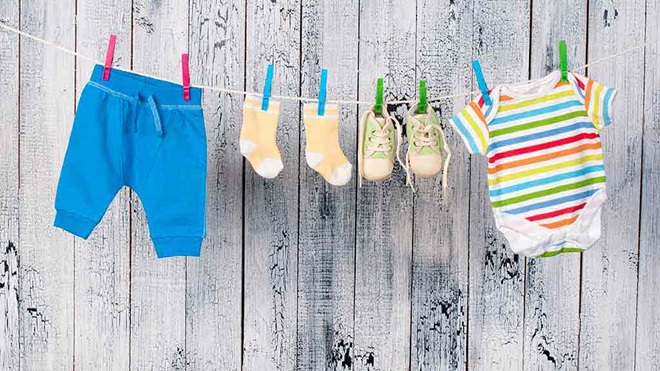The idea of stocking up for a baby before they arrive can be daunting; check out our tips for building a stress-free baby wardrobe.
On this page:
What are the absolute essentials?
- Six to eight singlets and jumpsuits will be a good start as babies can go through a surprising number of outfits – particularly with leaking nappies.
- Depending on the temperature, consider two long-sleeved tops or jackets for cool days and a couple of pairs of socks. Size 000 is usual for a newborn but you may find you'll need some 0000 items in the first few weeks for smaller babies.
- Velcro, press studs, snap-crotch jumpsuits, and wide openings will all help your bundle of joy be dressed, changed and undressed with minimal fuss.
What to look for in baby clothing
Natural fibres
Wool and cotton breathe and have very good insulating properties while allowing perspiration to evaporate. Natural and synthetic mixes are also OK for most babies. Some babies' skins can redden after contact with synthetic fabrics.
All-in-ones
Also known as jumpsuits or onesies, these little suits are not only very cute but keep the baby warm, stop nappy and singlet from drifting apart, and give you easy access to the nappy. Look for jumpsuits with press-studs (also known as snap fasteners) all the way up the front (and down both legs if there are legs). These are easier than buttons or zips and you don't have to pull the outfit over your baby's head.
If the jumpsuit has feet, you can extend its life by cutting off the ends when the baby gets bigger, but don't wait until bub's feet begin to look squashed.
Pullovers
Boat-neck or envelope-neck pullovers or sweatshirts are easier to put on than those with a smaller crew neck. Jackets with press-studs or buttons at the front are another good option.
Hats
At least one winter hat is recommended for cool-day outings, as babies lose a lot of heat from their heads. A sunhat is a good idea if they're in a carrier, but might get hot if they're already shaded in a pram.
Socks
Make sure socks are not too tight, and avoid patterned socks; little toes and toenails can get caught on the looped threads inside. Shoes are not needed until children start to walk.
Bibs
The larger, terry-towelling bibs with a Velcro closure are best; strings will tangle. Plastic-backed bibs keep bub's clothes dry, but may not be as absorbent. Bibs with a close-fitting crew neck aren't as easy to get on but help prevent gunge collecting in neck folds (ah, the joys of parenting!).
Fire-safe nightclothes
The most recent mandatory standard for nightwear came into effect in 2019. After 1 January 2020, manufacturers must comply with these requirements, which are based on the voluntary Australian and New Zealand Standard, AS/NZS 1249:2014. Clothes are classified into one of four categories dependent on the type of garment. For example, a Category 1 garment could be a slow burning wool, while a Category 3 could be a close-fitting onesie with a low fire risk. Category 4 garments have a high fire danger.
According to the Sydney Children's Hospitals Network fact sheet, cotton and rayon generally burn more easily. Synthetic fibres may be slower to ignite but can melt and stick to skin once alight. Silk and wool are slower to burn.
When you shop, check garments for labels that indicate the clothing's fire danger:
'Caution: Keep away from heat and flame'
These clothes have a low fire hazard and are slower to burn. They fall into categories 1 through 3.
'Warning: High fire danger, keep away from heat and flame'
This indicates that the garment is highly flammable (category 4).
The ACCC continues to crack down on retailers that fail to display suitable safety warnings on garments. In August 2016 the Federal Court ordered online retailer Ozsale to pay a total of $500,000 in penalties for supplying children's nightwear which did not comply with the Australian mandatory safety standard, and for failing to have adequate compliance processes in place.
See the ACCC's Product Safety website for an up-to-date list of baby clothing recalls.
Stock images: Getty, unless otherwise stated.




